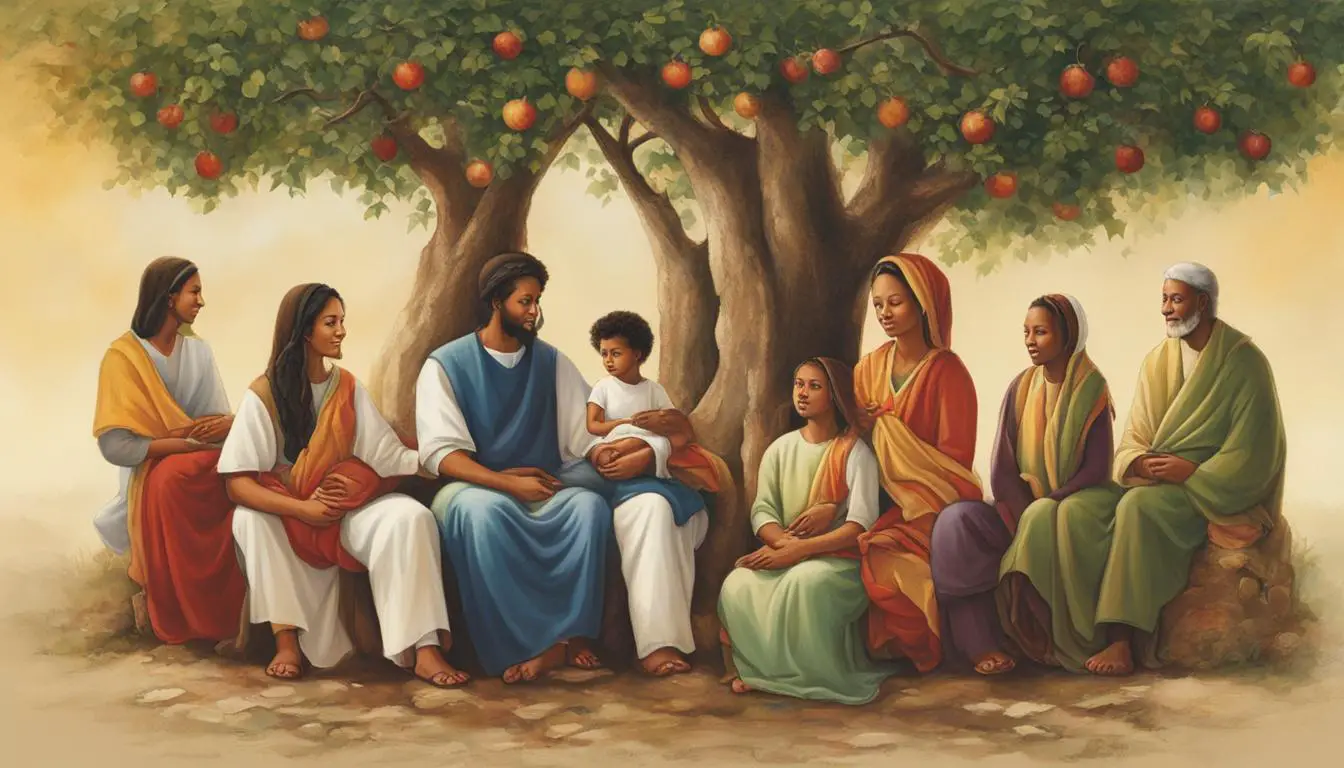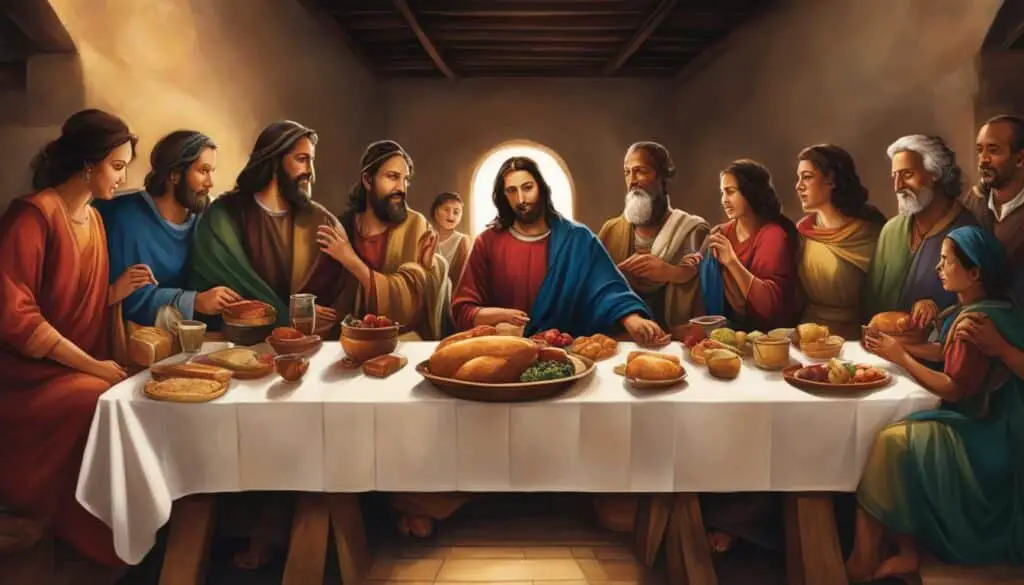
The family structures and relationships depicted in the Bible provide a diverse and profound exploration of the human experience. From the Old Testament to the New Testament, biblical narratives offer insights into various family structures, types, and dynamics, highlighting the significance of marriage and family in the context of faith.
Key Takeaways:
- The Bible presents a range of family structures, including multigenerational households, clans, and nuclear families.
- Family units in the Bible are not restricted to blood relatives but can also include servants and prisoners of war.
- The biblical teachings emphasize the roles of love, respect, and mutual submission within the family.
- Parenting advice in the Bible stresses the importance of teaching and modeling godly values.
- The husband-wife relationship and the nurturing of children are foundational elements in biblical family units.
Biblical Guidance on Family Relationships
In the Bible, we find profound teachings on family relationships, offering valuable guidance for individuals seeking to cultivate healthy and harmonious dynamics within their households. These teachings shed light on various aspects of family life, including roles, principles of interaction, parenting, and values. By exploring these timeless biblical principles, we can gain insight into fostering strong and loving relationships within our families.
Roles within the Family
A central theme in biblical teachings on family is the importance of roles. Ephesians 5:22-33 emphasizes the mutual submission and love between husbands and wives. Husbands are called to sacrificially love their wives, just as Christ loved the church, while wives are encouraged to submit to their husbands. This teaching highlights the significance of selfless love and respect in marriage, creating a foundation of trust and unity.
“Husbands, love your wives, just as Christ loved the church and gave Himself up for her. Wives, submit yourselves to your own husbands as you do to the Lord.” – Ephesians 5:25, 22
Furthermore, the Bible instructs parents to guide their children with love and discipline. Ephesians 6:1-4 emphasizes the importance of obedience for children and encourages fathers not to provoke their children to anger. This teaching acknowledges the significance of a nurturing and supportive environment, where children can grow and thrive under the guidance of their parents.
Principles of Family Dynamics
The Bible provides principles for healthy family dynamics, emphasizing love, respect, and mutual submission as foundational elements. These principles promote open communication, teamwork, and the cultivation of a peaceful atmosphere within the home. By applying these principles, families can develop strong bonds and create a nurturing environment for each family member.
Biblical Parenting and Family Values
The Bible offers valuable guidance for parents, emphasizing the importance of imparting godly values to their children. Proverbs 22:6 instructs parents to train up their children in the way they should go, ensuring they grow up with a solid foundation in faith and righteousness. Deuteronomy 6:6-9 further emphasizes the importance of teaching God’s commandments diligently to children, both through words and actions.
By following the teachings of the Bible and incorporating these principles into their lives, individuals can cultivate healthy, loving, and thriving family relationships. The biblical guidance on family provides a timeless framework for building strong and godly households that serve as a testament to the power of love, respect, and mutual submission.

Family Units in the Old and New Testament
The Old and New Testaments provide us with a glimpse into various family units that existed during biblical times. Understanding these family structures can give us insights into the dynamics and values associated with marriage and family in the Bible. Let’s explore some biblical examples of family units and how they reflect the divine design for the family.
Old Testament Family Units
In the Old Testament, we see a predominant focus on extended households and clans. These family units consisted of multiple generations living together, sharing resources, and providing mutual support. It was common for an entire clan to live in close proximity, forming a strong community bond. These larger family units served as a form of protection, as well as a means to ensure the continuity of the family lineage.
One notable example of an Old Testament family unit is found in the story of Abraham and Sarah. They formed the foundation of the Israelite nation and their descendants became a large and influential clan. The extended family unit included Abraham, Sarah, their children, grandchildren, and even slaves and servants who were considered part of the household. This multigenerational family structure played a crucial role in the fulfillment of God’s promises to Abraham.
New Testament Family Units
In contrast to the Old Testament, the New Testament presents us with smaller family units, often in urban settings. This shift can be attributed to cultural changes and the influence of the Roman Empire. The basic family unit in the New Testament consists of a husband and wife, along with their children. This nuclear family structure is emphasized in various teachings and instructions given by Jesus and the apostles.
An example of a New Testament family unit is seen in the household of Aquila and Priscilla. They were a married couple who worked together in tentmaking and were active members of the early Christian community. Their story demonstrates the partnership and unity between husbands and wives in serving God and His Kingdom.
| Family Unit | Old Testament | New Testament |
|---|---|---|
| Structure | Extended households and clans | Husband, wife, and children |
| Community | Close-knit families and clans living in proximity | Smaller nuclear families in urban settings |
| Role and Function | Maintaining family lineage and providing mutual support | Reflecting God’s design for marriage and raising godly children |
By studying family units in the Old and New Testament, we can gain a deeper understanding of the biblical principles that underpin marriage and family. These examples provide us with insights into the importance of intergenerational relationships, community, and the roles each family member plays in the divine plan. As we strive to build strong and flourishing families today, let us draw wisdom and inspiration from the examples set forth in the Bible.

Conclusion
The Bible provides a comprehensive understanding of family structures and relationships, offering valuable guidance for today’s families. Through biblical examples, we see a diverse range of family units, from extended households and clans in the Old Testament to nuclear families in the New Testament. These examples reflect the fluidity and adaptability of family structures, accommodating the complexities of life and history.
Biblical teachings emphasize the importance of roles within the family, highlighting the husband’s responsibility to love his wife and the wife’s call to submit to her husband. Children are also encouraged to obey their parents, while fathers are urged to nurture their children with gentleness and understanding. These teachings provide a blueprint for healthy and balanced family dynamics, based on love, respect, and mutual submission.
Furthermore, the Bible offers valuable guidance on parenting, emphasizing the importance of instilling godly values and modeling them in the family. By prioritizing the spiritual growth and well-being of children, parents can play a significant role in shaping their character and faith.
Studying the biblical teachings on family can provide wisdom and insight for building strong and flourishing families today. By adopting these principles, we can create a solid foundation for harmonious relationships, foster a nurturing environment, and cultivate values that reflect the image of God. Let us embrace the timeless wisdom of the Bible in our pursuit of healthy and godly family structures and relationships.
FAQ
What are the main types of family structures in the Bible?
The main types of family structures in the Bible include male-headed, multigenerational households known as “beth-avs,” as well as extended households, clans, and tribes.
What guidance does the Bible provide on family relationships?
The Bible emphasizes the importance of roles within the family, calling husbands to love their wives and wives to submit to their husbands. It also instructs children to obey their parents and urges fathers not to provoke their children.
What are some examples of family units in the Old and New Testament?
In the Old Testament, we see extended households and clans living in close proximity. In the New Testament, we see smaller household units, often in urban settings. The basic family unit in the Bible consists of a husband and wife, along with their children.
How can studying the Bible help in building strong families?
By studying the biblical teachings on family, we can gain wisdom and insight into building strong and flourishing families. The principles found in the Bible can serve as a guide for healthy and godly family relationships.








